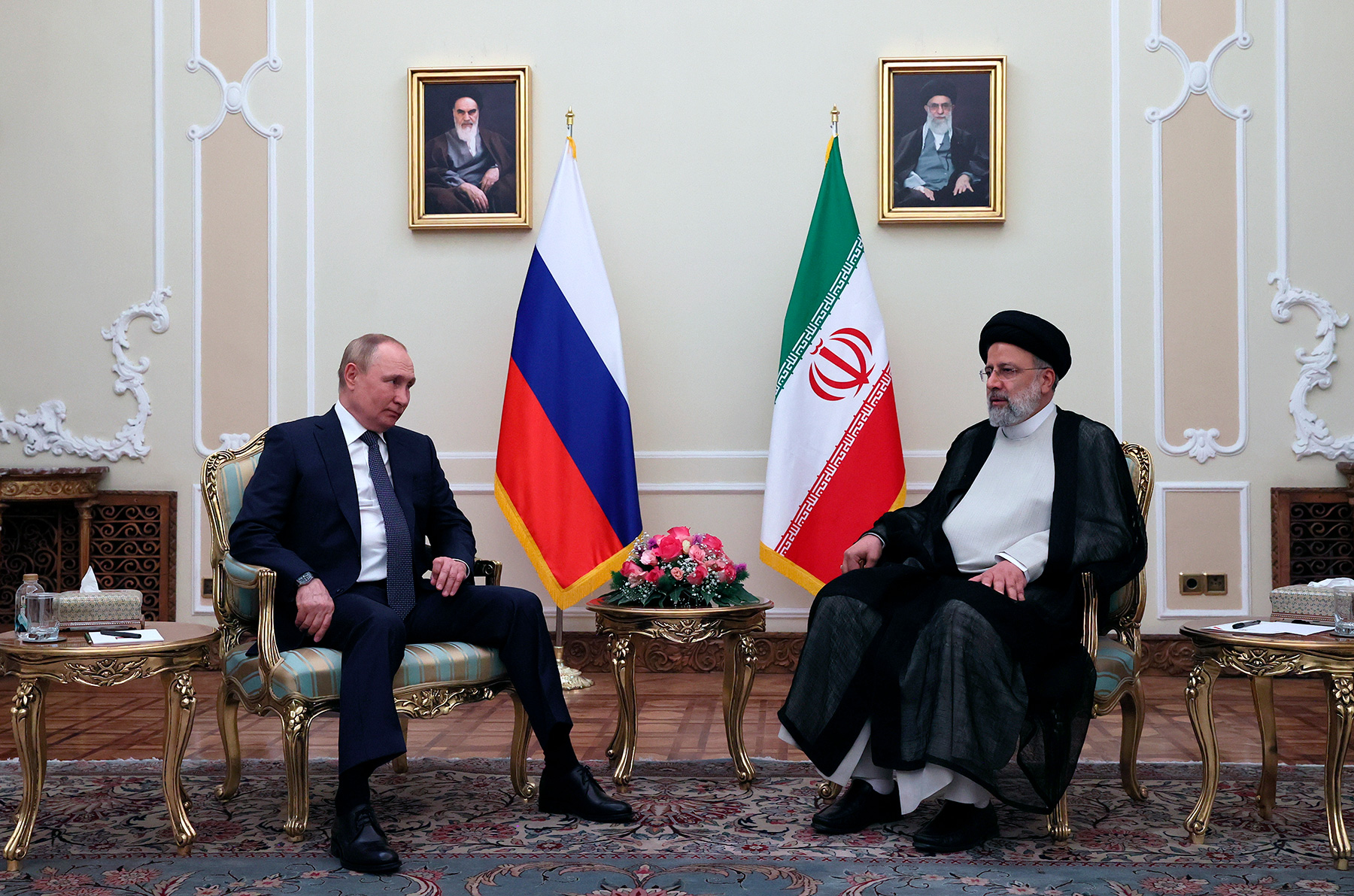Biden’s post-Bush, post-Obama and post-Trump Middle East strategy looks like a desire to find a middle ground between two extremes: over-involvement in the regional set-up coupled with military intervention or a complete turn toward the Indo-Pacific. That is, there is an understanding that the U.S. cannot change the Middle East, nor can it afford to withdraw from it. At the same time, the focus on countering Russia and China, which allegedly took advantage of the vacuum in the region, remains part of this adjusted strategy, much as the pivot to mobilize traditional Arab partners to achieve U.S. goals. And that is where the main contradiction lies. The U.S. plan for a regional alliance of democracies has no real prospect in the Middle East. The results of Biden’s Middle East trip clearly showed that, in contrast to the times of the Soviet-American confrontation, the Arab countries pursue a diversified policy, avoiding a strictly one-sided orientation on the principle of “the enemy of my friend is not my enemy.” With a new round of global confrontation, the leaders of these countries tread carefully, without closing foreign relations on unstable alliances and believing that their national interests in the new geopolitical and regional realities are more consistent with maintaining a situational partnership with the major powers.
One should not expect a dramatic turnaround in the U.S. Middle East policy. The incumbent president will have to reckon with the balance of power in Congress, which cannot be changed by executive orders. The Middle East will remain a focus of the Democratic administration, albeit not a top priority. The new style, with its emphasis on multilateral diplomacy, will help set a more balanced course toward key regional issues. At the same time, the Biden administration will not be able to ignore that Russia’s multi-vector policy has shown its relevance over the past two decades. The new reality in the Middle East will force American diplomacy to seek interaction points with Russia through overcoming the credibility gap, even in the face of tense bilateral relations. The question is whether it is possible to separate the Middle East from the context of the real geopolitics unfolding at odds. In this sense, Syria will be an important indicator of U.S. intentions, being a country where both Washington and Moscow, like in Europe, are in direct military contact.
In contrast to the presidential elections of the past two decades, the new White House administration has faced great difficulties in shaping its Middle East policy. With internal division, polarization, political system failures and the unwavering pandemic, the Middle East has largely dropped out of U.S. foreign policy priorities. Shortly after his election, George W. Bush came up with the ambitious initiative of a Greater Middle East which entailed a democratic restructuring of the region; Barack Obama quickly sent a special envoy for the Middle East to mediate between Israel and the Palestinian Authority; and Donald Trump, by contrast, dashed a number of traditional constants in the policies of his predecessors. It took Joe Biden’s administration a long time to realize the place of this troubled region in the U.S. grand strategy. Trump left Biden a heavy and intricate legacy, with no room for continuity or a sharp change of course on all fronts.
The continued policy of confrontation with Russia and China, framed ideologically as that of a democracy vs. autocracy, implied a revision of the approach towards the Middle East and a need to restore trust globally, taking into account all the painful experiences of the U.S., especially after the fiasco in Iraq and Afghanistan. How to achieve this amid a shifting global balance of power—clearly, not in favor of the United States—and striking changes in the region where the U.S. is increasingly seen as a key regional player was exactly the question. As early as by President Obama’s second term, a kind of consensus had been reached in the U.S. after long discussions. Trump was also guided by it, although one of his first trips abroad was to Saudi Arabia. U.S. policy in the Middle East is overly militarized, while meddling in the region’s internal affairs and the resources invested do not yield proper political impact. This leads to the conclusion that the U.S. military presence and political commitments should be reduced, avoiding overstretching in the face of emerging global threats and challenges.
The president and the secretary of state were critical of their predecessors, while devising their own approach to the region, with its unresolved conflicts and socio-political cataclysms, was clearly delayed. There has been a sense of uncertainty in the Arab world as to how and when Joe Biden would set a course for the Middle East. Questions arose as to whether one should prepare for a U.S. withdrawal from the region and Washington’s search for foreign policy alternatives. There were growing security concerns in the Gulf, which viewed Iran as a real threat. Namely, they believed that the U.S., having lost interest in the region, would decide to abandon its traditional guarantor role in the face of ongoing course corrections. Washington’s general words about “recalibration,” “redeployment,” and “reorientation” evoked mixed feelings: On the one hand, a desire for America to somehow define itself; on the other, a loss of confidence in it. The prolonged lack of progress in reaching agreement on the terms of a U.S. return to the JCPOA and the uncertainty over the parties’ future intentions were perceived with concern by Washington’s regional partners; not only by the Arab monarchies but also by Israel. The complicated domestic situation in Israel after the establishment of a shaky two-headed coalition and the prospect of a fifth edition of parliamentary elections in the last four years have put U.S. diplomacy in an ambiguous position.
The negative for the United States impact of the Ukrainian crisis on global energy as well as predominantly neutral attitudes towards the crisis in the non-Western world, which is somewhat closer to understanding Russia’s motives, seemed to serve as a stimulant that prompted Washington to shift its attention back to the Middle East—especially since the current conditions on the oil market have led to a significant increase in fuel prices in the U.S., which could have an adverse impact for the U.S. administration in light of the approaching midterms.
In this environment, the announcement of Biden’s upcoming trip to the Middle East on July 15-16 was met with a lot of skepticism, especially within America. The visit to Saudi Arabia came in for particular criticism because Biden promised to make Riyadh a “pariah” after the brutal assassination of Saudi journalist Khashoggi, and he was now planning to rehabilitate it in favor of domestic interests. Biden himself was forced to speak publicly to put the purpose of his visit to the Middle East in a broader global and regional context.
The pessimistic sentiments in the U.S. expert community were vividly expressed by Daniel Kurtzer and Aaron David Miller, two retired senior diplomats who worked for years in the Middle East and at the State Department under Presidents Ronald Reagan and George H.W. Bush. The essence of this image, translated into political language, is as follows: “If you plant a garden and go away for six months, what have you got when you come back? Weeds.” Biden deprioritized the Middle East for sixteen months, and the weeds have grown in the meantime. And so the president was sent on a “diplomatic foray into the region to plant U.S. flags and start to repair the damage done to the flowers and greenery.” The conclusion is that the pivot to the Middle East will not last long, and one should not expect quick pay-offs.
The itinerary from Tel Aviv to Jeddah, where, alongside with the bilateral U.S.-Saudi negotiations, the U.S. president met with a number of Arab leaders in the GCC+3 format (Egypt, Iraq, Jordan) is quite telling. This list indicates the states the Biden administration intends to bet on as well as the range of oft-interrelated problems, the approaches to which the administration considers necessary to clarify and harmonize. These include regional security, continued normalization of the Arab-Israeli relations, the issue of a U.S. return to the JCPOA, warning signals to Iran, a new understanding of the nature of allied relations, conflict resolution with a focus on Yemen, continued Palestinian-Israeli contacts, etc.
The Israeli part of Biden’s trip showed that the United States was not going to revise the legacy of the previous administration, which formally declared Israeli settlements in the West Bank not contrary to international law and recognized Jerusalem as the capital of the State of Israel. By and large, the status of Jerusalem, like the issue of Jewish settlements, is a fait accompli for the United States. At the same time, Biden reiterated his support for a two-state solution to the Israeli-Palestinian conflict—it was a purely formal gesture, though: more of a tribute to his election campaign. This position is also enshrined, albeit one-sidedly, in the Jerusalem U.S.-Israel Strategic Partnership Joint Declaration. Apart from passing remarks about his intention to promote dialogue with the Palestinians and provide humanitarian grants, the American president’s visit to the Palestinian Authority was more of a touristy, humanitarian nature. The text of this widely circulated declaration leaves no doubt that the U.S. continues to pursue the principled policy of ensuring Israel’s security and military dominance as “strategic commitments that are vitally important to the national security of the United States itself.” In this regard, we have seen additional measures of cooperation in air defense and laser technology development. Another important point of the declaration was the message to the U.S. partners in the region that America will “never allow Iran to acquire a nuclear weapon” and will work with them “to confront Iran’s aggression and destabilizing activities.” Finally, the U.S. and Israel praised the Abraham Accords as a critical addition to Israel’s strategic peace treaties with Egypt and Jordan and an important starting point for building a new regional security system.
The most complicated and sensitive part of the president’s Middle East tour—the trip to Saudi Arabia—had two dimensions to it. First, a normalization of the long-struggling bilateral relations with a new focus on the policies of Trump and Obama; and second, a presentation of the U.S. administration’s vision of the Middle East strategy.
On the bilateral agenda, Biden tried to find some middle ground in the eternal conflict between “American values” and “national interests,” between respecting human rights and supporting rigid autocracies, which in the United States, i.a. among Democrats, include the Kingdom of Saudi Arabia. There has been a heated debate in the United States over the dilemma where the prestige of a powerful figure in the kingdom, like Crown Prince Mohammed bin Salman, has been directly affected by Khashoggi’s assassination. Did the U.S. president raise human rights issues with the Crown Prince and what was his reaction? Responding to the numerous questions, the president confirmed that he had discussed this issue “directly and openly,” though there remained great doubt in U.S. domestic political discourse about the administration’s determination (and that of Biden personally) to put ideological values above practical considerations. The reaction of the Saudi leadership was no less direct. As it became known in the Arab world, Mohammed bin Salman replied briefly: “And what about Shireen Abu Akleh?” (a journalist of Palestinian origin murdered in Israel). In general, the contrast between the way Americans “defend” democracy and human rights in Ukraine and the way they do it for the Palestinians in the Arab world has not gone unnoticed. This partly explains no mention of the Ukrainian conflict in the negotiated documents from the Arab side.
The U.S. president’s trip to the Middle East was the occasion for the public announcement of a revised foreign policy in its regional dimension. Biden thought it was symbolic that he was the first U.S. president to come to Saudi Arabia from Israel and the first to visit the region at a time when the U.S. has no military personnel engaged in military operations there. Thereafter, the U.S. emphasized intensive diplomacy with the caveat that the use of force is seen as a last resort when all other options have been exhausted.
The U.S. Middle East strategy is presented in five main areas. First, the U.S. will not leave a vacuum to be filled by China, Russia, or Iran, so it is not withdrawing from the region. Washington will bolster partnerships with countries that subscribe to the rules-based international order, making sure these countries can defend themselves against foreign threats. Second, security cooperation. The U.S. will pledge determination to ensure the freedom of navigation through the Middle East’s waterways, including the Strait of Hormuz and the Bab el-Mandeb, to prevent dominance by any country. Third, de-escalation and termination of regional conflicts. The U.S. is ready to work with the partners to counter threats from Iran by forcing it to curtail its nuclear program. Fourth, the development of bilateral political, economic, and security connections, and the promotion of regional projects in energy, free trade and investment. Fifth, the U.S. commitment to human rights, fundamental freedoms and the values enshrined in the U.N. Charter.
It remains a matter of debate how the American president’s significant statements in the Middle East with a leadership bid can convert into practical policy. At the same time, growing tensions in Europe and Asia are gradually pushing Joe Biden's trip into the background. Assessments of the prospects for achieving the goal in practice are rather restrained, ranging from a complete disbelief in the U.S. ability to achieve ambitious goals in a rapidly changing region to assertions that Biden should be given time and that America still has chances to adjust its Middle East policy to the new realities in the world and in the United States itself. Looks like Biden took some not-so-heavy political baggage from the Middle East. U.S. attempts to present Saudi Arabia’s consent to overflight of its airspace by Israeli civilian aircraft as a breakthrough were quickly devalued by the Saudis’ official explanations that it was only about facilitating international air communications, not about normalizing relations with Israel. The Saudis have also made adjustments to the definition of the U.S. role in lowering oil prices. Minister of State for Foreign Affairs Al-Jubeir hastened to declare that the decision will be based on market assessments, and Saudi Arabia intends to continue consultations with OPEC members as well as within OPEC+, i.e. with Russia. The Saudis oppose the politicization of the global financial system and do not support calls for an oil embargo. According to experts, if the decision to further increase oil production was made, such an increase wouldn’t be so critical that the U.S. could take the credit.
Biden’s post-Bush, post-Obama and post-Trump Middle East strategy looks like a desire to find a middle ground between two extremes: over-involvement in the regional set-up coupled with military intervention or a complete turn toward the Indo-Pacific. That is, there is an understanding that the U.S. cannot change the Middle East, nor can it afford to withdraw from it. At the same time, the focus on countering Russia and China, which allegedly took advantage of the vacuum in the region, remains part of this adjusted strategy, much as the pivot to mobilize traditional Arab partners to achieve U.S. goals. And that is where the main contradiction lies. The U.S. plan for a regional alliance of democracies has no real prospect in the Middle East. The results of Biden’s Middle East trip clearly showed that, in contrast to the times of the Soviet-American confrontation, the Arab countries pursue a diversified policy, avoiding a strictly one-sided orientation on the principle of “the enemy of my friend is not my enemy.” With a new round of global confrontation, the leaders of these countries tread carefully, without closing foreign relations on unstable alliances and believing that their national interests in the new geopolitical and regional realities are more consistent with maintaining a situational partnership with the major powers.
Strengthening the U.S. strategic partnership with Israel at the expense of the right of the Palestinian people to their statehood is unlikely to advance further normalization of Israel’s relations with the Arab world, but rather will complicate the country’s integration into the region. As a result, one can expect a sharp rise in radical sentiment among the Palestinians, with the support of the resistance front by Arab states. This is evidenced by the restoration of Hamas’ relations with Syria, the meeting of all Palestinian factions in Algeria facilitated by the movement, as well as the recent escalation in and around the Gaza Strip. In security issues, the Gulf monarchies are not prone to vest their security concerns with the U.S.—instead, they are looking for opportunities to defuse tensions with Iran through regional mediation as an alternative to U.S. guarantees.
One should not expect a dramatic turnaround in the U.S. Middle East policy. The incumbent president will have to reckon with the balance of power in Congress, which cannot be changed by executive orders. The Middle East will remain a focus of the Democratic administration, albeit not a top priority. The new style, with its emphasis on multilateral diplomacy, will also help set a more balanced course toward key regional issues. At the same time, the Biden administration will not be able to ignore that Russia’s multi-vector policy has shown its relevance over the past two decades. The new reality in the Middle East will force American diplomacy to seek interaction points with Russia through overcoming the credibility gap, even in the face of tense bilateral relations. The question is whether it is possible to separate the Middle East from the context of the real geopolitics unfolding at odds. In this sense, Syria will be an important indicator of U.S. intentions, being a country where both Washington and Moscow, like in Europe, are in direct military contact.







